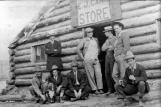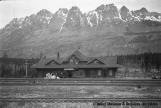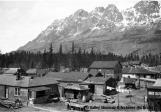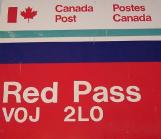14
Bootlegging whiskey at Tete JauneTete Jaune Cache, British Columbia, Canada
 Credits:
Credits:Mildred Tillberg
15
Bootlegging was a popular business in Tete Jaune, as it was in all railway tent towns. The camps were lively and rough in their day. The Royal Mounted Police had jurisdiction only to the border of Alberta; thus, the camps were especially raucous on the B.C. side. The federal government banned alcohol from the camps and the railroad, but the men came up with all sorts of ingenious ways to import their favourite drinks including hiding bottles in bales of hay, sacks of provisions, packsaddles, almost anything that would cover the bottles of whiskey until they could be delivered.Whiskey bottles, like these brought inside these pigs, were selling for ten dollars a piece. This shipment was intercepted by Chief Beytes and other provincial police at Tete Jaune.
16
Stations: Summit City, Mile 1, GTP camp, E.J Cann store1910-1911
Summit City, Mile 1, British Columbia, Canada
 Credits:
Credits:L.J Cole photo / Donated by H.A. Cole
19
During construction, Mile 27 was just another camp along the rail line. It was largely abandoned, until 1923. That year Canadian National took over both railways. Mile 27 was named Red Pass after the red tinted rock on the ridges above. East of Red Pass, the trains used one track, instead of the original two. At Red Pass, the rail split.After Red Pass was established as a divisional point, it became a regular town, with a school, grocery store, post office, and station. A hotel was built in 1926 but burnt down in 1949. The largest population that inhabited Red Pass was 96 in 1940.
21
(Most likely) Left to Right: Station agent Art Blair, Dad Woodley from store, section man John Ruska, section man from Foster John Stefano, section man from Red Pass Fred Guzik, section man from Foster John Postenuk, section foreman from Foster Mike Zak, (unknown), Mrs. Sivecki with Lionel Deforge right behind her on the gas car; section man Felix Sivecki, daughter-in-law to Dad Mrs. Woodley, (unknown), (unknown), the man behind (unknown) and operator at Red Pass Jim Bremenor.22
Red Pass before 1949; colour tinted at a later dateRed Pass, British Columbia, Canada
 Credits:
Credits:Ishbel Cochrane
23
After the highway opened in 1962, the need for Red Pass diminished. CN still uses some buildings at Red Pass.24
Lucerne station1919
Lucerne, British Columbia, Canada
 Credits:
Credits:Runnalls Collection
Valley Museum and Archives (McBride)
25
Lucerne was the largest community in the Robson Valley after the railroad construction boom. Situated at Mile 5 on the CNoR line, Lucerne boasted a registered population of 300 in 1921 with all the amenities of a divisional point.26
Lucerne town1919
Lucerne, British Columbia, Canada
 Credits:
Credits:Runnals Collection
Valley Museum and Archives (McBride)
27
The trains needed the roundhouse, coal triple, and marshalling yard in Lucerne. Lucerne also had an icehouse, which stored large blocks of ice cut from the lake in the winter for the railroad. The ice would be covered with sawdust and kept through the summer for use on passenger and refrigerator cars.A flu epidemic ravaged Lucerne in 1918, and the graveyard still remains. In 1923, the roundhouse was moved from Lucerne to Jasper. Though a few people remained, most of the buildings were moved to Jasper; Lucerne sank into obscurity.


